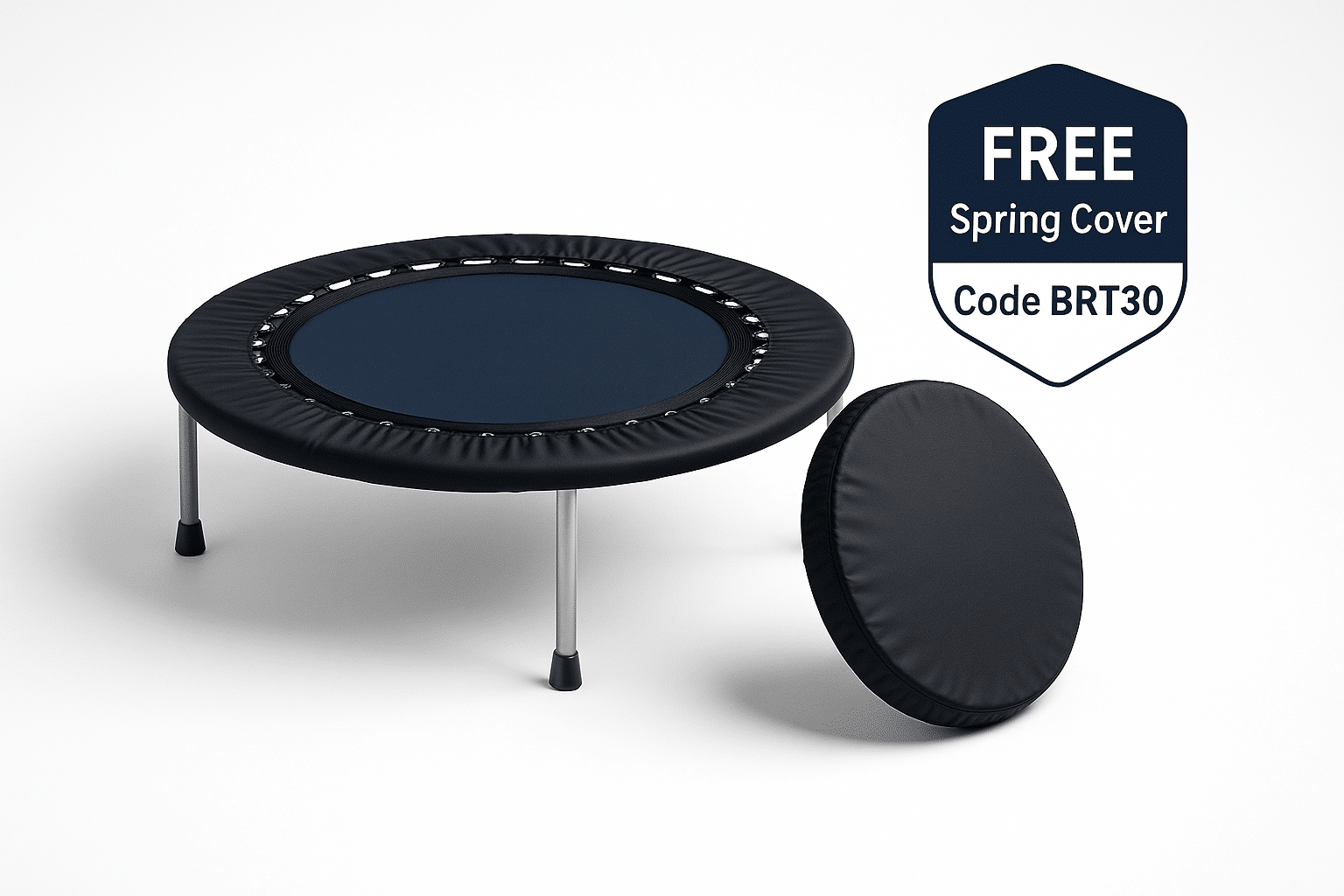What Is a Rebound Trampoline and How Does It Work?
A rebound trampoline is a specialized type of trampoline designed primarily for individual exercise and fitness activities. Unlike traditional trampolines that are often used for recreational activities or acrobatics, rebound trampolines are typically smaller and have a lower height from the ground. They are specifically built to provide low-impact workouts that can enhance cardiovascular health and improve muscle strength.
Rebound trampolines consist of a flexible, elastic surface stretched over a sturdy frame. When a user jumps on the mat, the elastic tension created by the surface absorbs the impact, allowing for bouncy movements that are gentle on the joints. This low-impact design makes rebound trampolining an ideal form of exercise for people of all ages, from children to seniors. It offers a fun and engaging way to stay active without the risk of injury commonly associated with high-impact exercises.
How Do Rebound Trampolines Work?
The mechanism behind a rebound trampoline is straightforward yet fascinating. Here’s how it operates:
- Jumping Surface: Users bounce on the specially designed mat that provides resistance and gives back energy with each jump.
- Resistance Bands: Some models are equipped with resistance bands that enhance workout intensity by engaging additional muscle groups.
- Stability Features: Many rebound trampolines include handles or safety bars to help users maintain balance while exercising.
As users perform exercises, the trampoline absorbs most of the impact, reducing stress on the knees, ankles, and back. This unique design encourages rhythmic movements, aiding in coordination and balance. Rebound trampolines are not only enjoyable but also effective for cardio routines, strength training, and even flexibility exercises.
The Benefits of Using a Rebound Trampoline for Fitness
Rebound trampolines, often recognized for their playful nature, provide a multitude of fitness benefits that can enhance your overall physical well-being. One of the primary advantages is the low-impact cardio workout they offer. Unlike traditional running or aerobics, rebounding minimizes stress on joints while still delivering an effective cardiovascular exercise. This characteristic makes it particularly suitable for people of all ages and fitness levels, including those recovering from injuries.
Full Body Engagement
Another significant benefit of using a rebound trampoline is its ability to engage multiple muscle groups simultaneously. As you bounce, you activate your core, strengthen your legs, and tone your arms. This full-body workout not only improves muscle strength but also enhances coordination and balance. Incorporating various movements like twists or jumps can even target specific areas, allowing for a personalized fitness experience.
Enhanced Lymphatic Drainage
Moreover, rebounding can contribute to better lymphatic health. The up-and-down motion helps promote lymphatic drainage, which is vital for detoxification and overall immune function. This increased circulation accelerates the removal of toxins from the body, potentially leading to better skin health and improved energy levels.
Mental Wellness Boost
Finally, in addition to physical benefits, using a rebound trampoline can significantly elevate your mental wellness. The fun and engaging nature of rebounding often leads to the release of endorphins, commonly known as “feel-good” hormones. This natural mood booster can help alleviate stress and anxiety, making workouts enjoyable and positively impacting mental health.
FREE SHIPPING SELF-ASSEMBLY MODELS
Choosing the Right Rebound Trampoline: Key Features to Consider
Selecting the ideal rebound trampoline requires careful consideration of various key features that ensure safety, performance, and enjoyment. One of the primary factors is size. Rebound trampolines come in different diameters, typically ranging from 36 inches for personal use to larger models designed for family or group activities. The size you choose should be based on the available space as well as the number of jumpers expected at any given time.
Another important feature to examine is the weight capacity. Trampolines generally have weight limits ranging from 200 to 450 pounds, and choosing one that meets or exceeds your needs ensures safety and durability during use. Additionally, consider the frame material. High-quality trampolines often feature galvanized steel frames that prevent rusting and enhance longevity. Look for models with a powder-coated finish for added protection against the elements.
Spring type also plays a crucial role in performance. There are two main types – traditional steel springs and elastic bungee cords. Steel springs provide a firmer bounce that many experienced jumpers prefer, while bungee cords can offer a softer, gentler rebound, which may be more suitable for beginners. It’s essential to assess your jumping style and preference when deciding between these options.
- Safety features: Ensure your trampoline includes safety nets and padded edges to prevent injuries.
- Durability: Opt for trampolines with UV protection and weather-resistant materials for long-lasting use.
- Ease of assembly: Some models come with straightforward assembly instructions, making setup quick and hassle-free.
Finally, take note of the brand reputation and customer reviews. Trusted brands often provide better warranties and customer support, making your investment worthwhile. Be sure to compare various models and prioritize features that align with your specific needs for a satisfying rebound trampoline experience.
Common Misconceptions About Rebound Trampolines Explained
Rebound trampolines are often surrounded by a cloud of misconceptions that can deter potential users from experiencing their benefits. One of the most prevalent misunderstandings is the belief that rebound trampolines are solely for professional athletes or fitness enthusiasts. In reality, these trampolines are designed to accommodate all fitness levels, making them suitable for anyone looking to improve their cardiovascular health, coordination, and overall fitness.
Another common myth is that using rebound trampolines can lead to severe injuries. While any physical activity carries some risk, rebound trampolines are engineered with safety in mind. Many models come equipped with safety features such as padded edges and sturdy frames to minimize the risk of injury. Furthermore, when used correctly and with proper supervision, rebounding is a low-impact exercise that reduces stress on joints compared to many other workout forms.
Health Benefits of Rebound Trampolines
- Improved Cardiovascular Health: Bouncing can elevate heart rate, providing an effective aerobic workout.
- Enhanced Muscle Strength: Various exercises can target different muscle groups, promoting strength and endurance.
- Better Balance and Coordination: Regular use helps improve motor skills and body awareness.
- Stress Relief: The fun aspect of jumping can alleviate stress and improve mood.
Some individuals may also think that rebound trampolines are too noisy for home use. This concern, however, can be easily mitigated. Many modern rebound trampoline designs are relatively quiet, thanks to innovations in spring technology and frame construction. Thus, users can enjoy a great workout without disturbing others in their household or neighborhood.
FREE SHIPPING SELF-ASSEMBLY MODELS
Safety Tips and Best Practices for Using a Rebound Trampoline
Using a rebound trampoline can be an exhilarating experience, but it is important to prioritize safety to prevent injuries. To ensure a safe jumping environment, follow these essential safety tips:
1. Inspect the Trampoline Before Use
Before anyone starts bouncing, take a moment to inspect the rebound trampoline thoroughly:
- Check the Mat: Ensure the mat is free from tears or fraying. A damaged mat can increase the risk of falls.
- Inspect the Springs: Look for any signs of rust or corrosion. Secure and functional springs are vital for a safe bounce.
- Examine the Frame: Ensure that the frame is stable and free from any cracks or structural damage. A sturdy frame helps maintain safety during use.
2. Establish Rules for Usage
To foster a safe jumping atmosphere, establish clear rules that all users must follow:
- Limit Jumper Capacity: Only allow one jumper at a time to minimize the risk of collisions.
- No Tricks: Avoid acrobatics like flips or twists, which can lead to injuries if not executed properly.
- Supervision: Always have an adult present to supervise younger jumpers and enforce safety protocols.
3. Use Safety Gear and Enclosures
Utilizing additional safety measures can greatly reduce the chances of injury:
- Safety Pads: Always cover the springs and frame with safety pads to cushion falls.
- Net Enclosures: Consider installing a safety net enclosure to prevent jumpers from falling off the rebound trampoline.
- Appropriate Footwear: Use socks specifically designed for trampolining to maintain grip while preventing slips.
By adhering to these safety tips and best practices, you can create a safer, more enjoyable rebound trampoline experience for everyone involved. Prioritizing safety not only protects jumpers from injuries but also enhances the fun of bouncing and play.

Customer Engagement Manager
Michael Carter has been with Best Rebounder Trampoline for over 10 years, leading our customer engagement team with dedication and empathy. He has a background in health and wellness coaching and is committed to helping our readers achieve their fitness goals with personalized support and advice.




